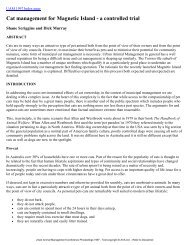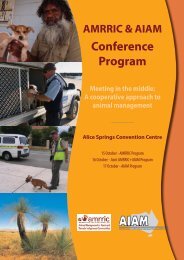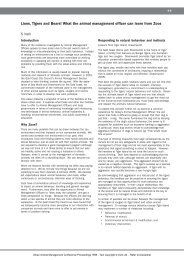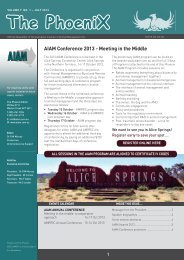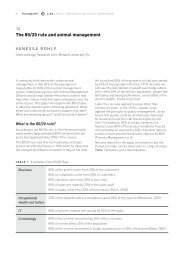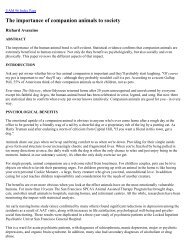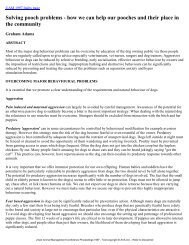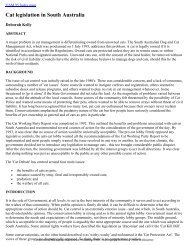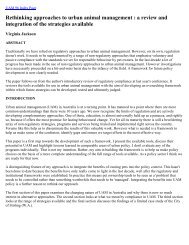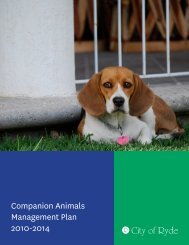Proceedings OF ThE - Australian Institute of Animal Management Inc
Proceedings OF ThE - Australian Institute of Animal Management Inc
Proceedings OF ThE - Australian Institute of Animal Management Inc
Create successful ePaper yourself
Turn your PDF publications into a flip-book with our unique Google optimized e-Paper software.
Annual Conference on <strong>Animal</strong> <strong>Management</strong> AIAM <strong>Proceedings</strong> 2012 109<br />
There is a noticeable ‘beach culture’ among dog<br />
owners, in particular during the morning. The same<br />
people tend to walk the same stretch <strong>of</strong> beach most<br />
days <strong>of</strong> the week, and most seem to know each other<br />
fairly well. This adds a good sense <strong>of</strong> community<br />
amongst dog owners, as they have no problems with<br />
other dogs coming up to them or their pet. This same<br />
culture is not quite as apparent in the afternoon. This<br />
group has been very receptive to the new education<br />
initiative and appears more compliant to the leash<br />
requirements along the foreshore in comparison to<br />
last year.<br />
With the introduction <strong>of</strong> a new casual beach uniform<br />
that featured “<strong>Animal</strong> <strong>Management</strong>” on the back <strong>of</strong><br />
a white top the <strong>of</strong>ficer was recognised easier as a<br />
Council employee by beach users. In comparison to<br />
last year people are more receptive and accepting<br />
<strong>of</strong> the education <strong>of</strong>ficer and in particular him<br />
encouraging dog owners to ensure dogs are kept on<br />
the leads and are practicing effective control. Last<br />
year people were found to be not quite as accepting<br />
<strong>of</strong> this education.<br />
Setting up the banners each shift did take some time<br />
to set up and take down. However, the mobility <strong>of</strong><br />
the banners allows for them to reach more beach<br />
users, and so spread the council’s message more<br />
effectively. During the time involved in setting up<br />
the banners each shift people have approached<br />
the education <strong>of</strong>ficer to converse about the banner<br />
messages and express their opinion or ask<br />
questions. This served as a good opportunity to build<br />
rapport with the public, and act as a ‘friendly face’ <strong>of</strong><br />
the council.<br />
It became quite noticeable that most people would<br />
immediately put their dog on the leash if the beach<br />
education <strong>of</strong>ficer was near. Most people would also<br />
do this if they walked past the education banners<br />
however some would still continue to keep their dog<br />
<strong>of</strong>f the leash.<br />
While the banners may help, it seems that the<br />
combination <strong>of</strong> a Council presence greatly increases<br />
compliance <strong>of</strong> dog owners on the beach.<br />
During the 16 shifts the <strong>of</strong>ficer undertook prior<br />
receiving the banners, he spoke to 30 dog owners<br />
who had their dogs running free during leashing<br />
times. In the next 16 shifts, this number increased<br />
to 35 dogs. While this may suggest that the banners<br />
are having no impact, anecdotal evidence from beach<br />
users, in particular non-dog owners, indicates that<br />
the banners may be having some influence, or at the<br />
bare minimum indicating to beach users than the<br />
council is attempting to minimise the incidence <strong>of</strong><br />
<strong>of</strong>f-leash dogs.<br />
Results<br />
The Beach Education Officer was asked to monitor<br />
and record the number <strong>of</strong> dogs witnessed <strong>of</strong>f leash<br />
and the number not under effective control during<br />
his patrols. Those dogs not under effective control<br />
were mainly recorded during the designated <strong>of</strong>fleash<br />
times.<br />
The table below shows a comparison <strong>of</strong> results from<br />
this year to last.<br />
Year<br />
Patrols<br />
Undertaken<br />
Off Leash<br />
during the<br />
On Leash<br />
times<br />
Not<br />
Under<br />
Control<br />
totAL<br />
<strong>of</strong>fences<br />
2011 32 74 14 88<br />
2012 47 78 13 91<br />
Although there is a slightly larger number <strong>of</strong> dogs<br />
witnessed <strong>of</strong>f leash, as the number <strong>of</strong> patrols have<br />
been increased this would indicate that this number<br />
has actually decreased.<br />
To compare the two we divided the number <strong>of</strong><br />
<strong>of</strong>fences by the number <strong>of</strong> patrols to give us the<br />
number <strong>of</strong> <strong>of</strong>fences observed per patrol.<br />
In 2011 2.3 <strong>of</strong>fences were observed per patrol in<br />
comparison to 2012 where only 1.6 <strong>of</strong>fences were<br />
observed per patrol.<br />
The number <strong>of</strong> dogs witnessed not under effective<br />
control has also decreased taking into consideration<br />
the number <strong>of</strong> increased patrols.<br />
Conclusion<br />
Establishing why dog owners fail to abide by leash<br />
laws is a difficult task however by implementing<br />
a survey to find the real issues behind the lack <strong>of</strong><br />
compliance provides us with the tools required to<br />
move forward with a tailored strategy. Taking into<br />
consideration that the intervention implemented<br />
was prompted by community concern the newly<br />
implemented strategy is showing positive results<br />
not only in compliance but also in acceptable by<br />
the community as a whole as well as dog owner<br />
behaviour.<br />
Conferences like those organised by AIAM give<br />
participants’ opportunity to not only share ideas and<br />
present findings but to look at ways to collaboratively<br />
tackle existing issues facing Councils. Through my<br />
work with Vanessa we were able to locate the root



